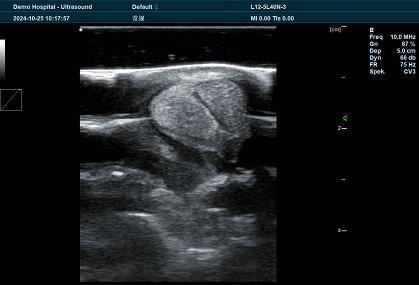In veterinary medicine, accurate diagnosis is the foundation of effective treatment. BXL Veterinary ultrasound has emerged as a powerful diagnostic tool, offering high-quality imaging for a range of animal health conditions. From pets to livestock, BXL ultrasound systems provide precise insights into internal organs, allowing veterinarians to diagnose diseases, monitor pregnancies, and assess overall health. This article explores the importance of BXL veterinary ultrasound diagnosis, its applications, and how to optimize its use for accurate results.

What is BXL Veterinary Ultrasound?
BXL Veterinary Ultrasound is a cutting-edge diagnostic imaging system designed specifically for use in veterinary practices. Utilizing sound waves, this ultrasound technology creates detailed images of an animal's internal structures, such as organs, muscles, blood vessels, and even blood flow, making it an invaluable tool for veterinarians.
Key Features of BXL Ultrasound Systems:
- High-Resolution Imaging: Provides clear, detailed images for accurate diagnosis.
- Multiple Probe Compatibility: Supports various probes suitable for different animal sizes and body types.
- Portability: Lightweight and easy to transport for both clinic and mobile use.
- Doppler Ultrasound: Measures blood flow, enabling veterinarians to assess cardiovascular health and identify circulatory issues.
Why Use BXL Veterinary Ultrasound for Diagnosis?
1. Non-Invasive and Safe
BXL ultrasound is a non-invasive procedure, meaning no incisions or radiation are involved. This makes it a safe option for diagnosing a wide variety of health issues in animals, from pregnancy checks to organ abnormalities.
2. Real-Time Results
Unlike traditional X-rays or other imaging methods, BXL ultrasound provides real-time imaging, allowing veterinarians to assess organ function and blood flow dynamically. This is particularly useful for monitoring conditions that may evolve rapidly, such as fluid buildup or internal injuries.
3. High Diagnostic Accuracy
BXL ultrasound machines provide high-quality images, enabling veterinarians to detect conditions that might otherwise go unnoticed. From detecting tumors to monitoring heart function, the clarity of these images aids in delivering precise diagnoses.
Applications of BXL Veterinary Ultrasound Diagnosis
BXL ultrasound systems can be used to diagnose and monitor a variety of conditions in animals, from routine check-ups to critical care situations. Here are some key applications:
1. Abdominal and Organ Health
BXL ultrasound is essential for assessing internal organs such as the liver, kidneys, spleen, and bladder. Conditions like liver disease, kidney stones, or bladder infections can be detected early, ensuring timely treatment.
2. Cardiology and Vascular Health
Doppler ultrasound capabilities allow veterinarians to evaluate the heart and blood vessels for conditions like heart murmurs, arrhythmias, and abnormal blood flow. By assessing the heart’s function and blood circulation, veterinarians can diagnose cardiovascular diseases in animals.
3. Pregnancy Monitoring
BXL ultrasound is widely used to monitor pregnancies in dogs, cats, horses, and other animals. Veterinarians can track fetal development, confirm pregnancy, and even detect potential complications, such as multiple births or abnormal positioning.
4. Musculoskeletal Health
For animals suffering from musculoskeletal injuries, BXL ultrasound can assess the condition of tendons, ligaments, and muscles, helping veterinarians diagnose strains, tears, and other soft tissue injuries.
5. Emergency Diagnostics
In emergency veterinary care, BXL ultrasound can help identify internal bleeding, trauma, or organ rupture, enabling veterinarians to make quick decisions and provide life-saving treatment.
How to Optimize BXL Veterinary Ultrasound for Accurate Diagnosis
To get the most out of BXL Veterinary Ultrasound for diagnosis, follow these best practices:
1. Proper Preparation of the Animal
- Shave the fur or hair from the area being examined to ensure good contact between the probe and the skin.
- Apply sufficient ultrasound gel to create an effective sound wave transmission.
2. Choose the Correct Probe
select the appropriate probe for the animal and procedure:
- Linear probes are best for imaging shallow organs and tissues.
- Convex probes are ideal for deeper abdominal scans in larger animals.
- Microconvex probes are great for smaller animals or detailed organ assessments.
3. Adjust the Ultrasound Settings
- Gain and Depth: Adjust the gain for image brightness and contrast. Set the depth to focus on the target area for better visualization.
- Frequency: Higher frequencies are ideal for superficial scans, while lower frequencies work better for deeper tissues.
4. Follow a Structured Scanning Protocol
Performing ultrasound scans systematically helps ensure all areas of concern are examined. For example, when conducting an abdominal scan, start with an overall assessment and then zoom in on specific organs, such as the liver, kidneys, or bladder.
Benefits of Using BXL Veterinary Ultrasound for Diagnosis
1. Fast and Accurate Results
BXL ultrasound provides real-time imaging, making it possible for veterinarians to make rapid diagnoses and begin treatment without delays.
2. Cost-Effective
Compared to other diagnostic imaging technologies like CT scans or MRIs, BXL veterinary ultrasound is more affordable, making it accessible to a wider range of veterinary clinics.
3. Non-Invasive Monitoring
Unlike surgical procedures or biopsies, ultrasound offers a safe, non-invasive way to monitor an animal's condition over time, reducing stress for the animal and the owner.
4. Portability
The portability of BXL ultrasound systems makes them ideal for mobile veterinarians or practices that need to provide diagnostics in the field, ensuring animals receive prompt care wherever they are located.
Conclusion
BXL Veterinary Ultrasound is a vital diagnostic tool that enhances the accuracy and efficiency of veterinary care. By providing detailed imaging for a wide range of applications—from organ health to pregnancy monitoring and emergency diagnostics—BXL ultrasound helps veterinarians make timely, informed decisions about treatment.
Whether you are a seasoned professional or a mobile vet offering services in the field, integrating BXL veterinary ultrasound diagnosis into your practice will undoubtedly improve diagnostic outcomes and provide better care for your animal patients.
tags: Veterinary Ultrasound DiagnosisVeterinary Ultrasound


